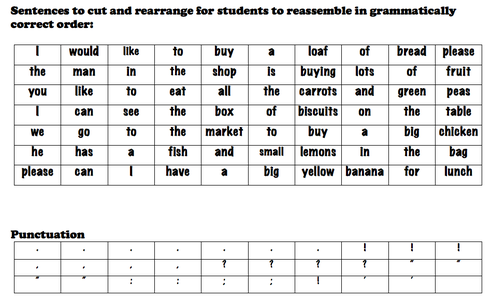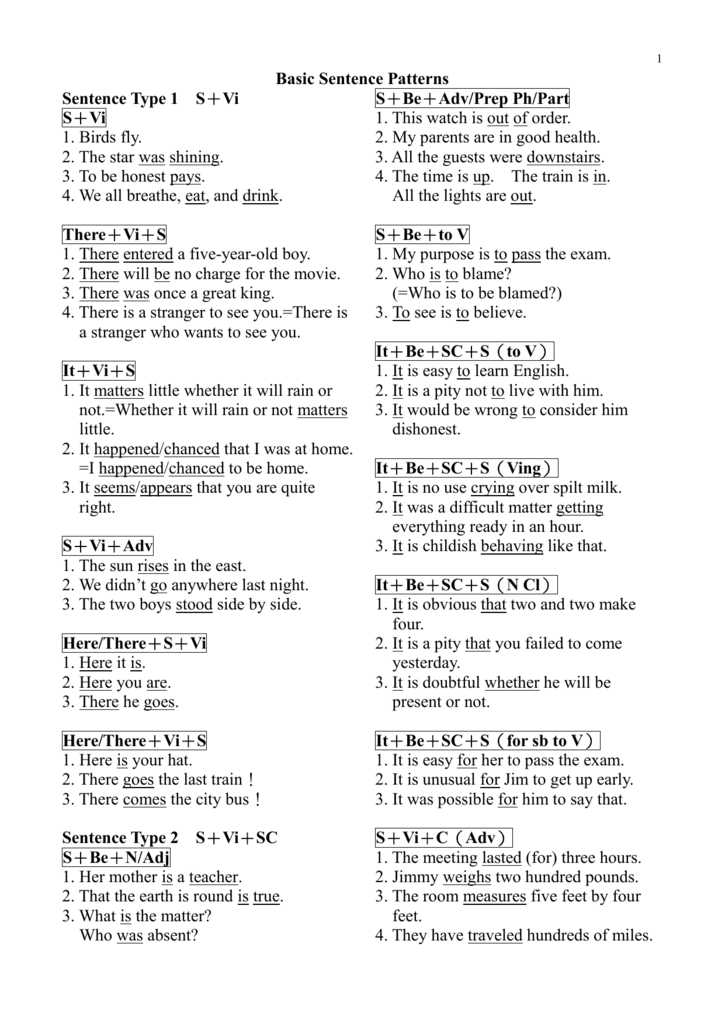Basic Sentence Patterns In English Pdf
Basic Sentence Patterns
Subject + verb
The simplest of sentence patterns is composed of a subject and verb without a direct object or subject complement. It uses an intransitive verb, that is, a verb requiring no direct object:
- Control rodsremain inside the fuel assembly of the reactor.
- The development of wind power practically ceased until the early 1970s.
- The cross-member exposed to abnormal stress eventually broke.
- Only two types of charge exist in nature.
Subject + verb + direct object
Another common sentence pattern uses the direct object:

- Siliconconductselectricity in an unusual way.
- The anti-reflective coating on the the silicon cell reducesreflection from 32 to 22 percent.
Subject + verb + indirect object + direct object
Basic Sentence Patterns. Subject + intransitive verb Elizabeth swims. Subject + transitive verb + direct object John hated lima beans. Books convey ideas. Subject: + linking verb + subject complement The sea is beautiful. You seem worried. Sentences in English and their English writing scores and abilities improved a lot after the action research. Keywords: writing incorrect sentences, non-English majors, basic sentence translation drills, action research 1. Introduction English writing has been regarded as an essential part in English learning for Chinese EFL learners.
The sentence pattern with the indirect object and direct object is similar to the preceding pattern:
- Related Topics: More Lessons on English Grammar IELTS, TOEFL and English as a Second Language In these lessons, we will learn the different ways of introducing the subject in a declarative sentence, basic sentence patterns and the types of sentence patterns.
- The English language has seven basic sentence (or clause) patterns. Examples are: John / laughed. (SV). John / kissed / Jane. (SVO) John / is / tall. (SVC) John / gave / Jane / a present.
- Iam writingher about a number of problems that I have had with my computer.
- Austin, Texas, has recently built its citizens a system of bike lanes.
Practice
Identify the basic sentence pattern of the sentences below. What are the different parts of each sentence?
- All amplitude-modulation (AM) receivers work in the same way.
- The supervisor mailed the applicant a description of the job.
- We have mailed the balance of the payment in this letter.
- This is a subject + verb sentence:
- All amplitude-modulation (AM) receiverswork in the same way.
- This is a subject + verb + indirect object + direct object sentence:
- The supervisormailed the applicant a description of the job.
- This is a subject + verb + direct object sentence:
- Wehave mailed the balance of the payment in this letter.
Sentence Types

Simple Sentences
A simple sentence is one that contains a subject and a verb and no other independent or dependent clause.
- One of the tubes is attached to the manometer part of the instrument indicating the pressure of the air within the cuff.
- There are basically two types of stethoscopes.
- In this sentence, the subject and verb are inverted; that is, the verb comes before the subject. However, it is still classified as a simple sentence.
- To measure blood pressure, a sphygmomanometer and a stethoscopeare needed.
- This sentence has a compound subject—that is, there are two subjects—but it is still classified as a simple sentence.
Command sentences are a subtype of simple sentences. These sentences are unique because they don’t actually have a subject:
- Clean the dishes.
- Make sure to take good notes today.
- After completing the reading, answer the following questions.

In each of these sentences, there is an implied subject: you. These sentences are instructing the reader to complete a task. Command sentences are the only sentences in English that are complete without a subject.
Punctuation Patterns
Simple sentences have these punctuation patterns:
- ________________________________.
- ________, ________________________.
Compound Predicates
A predicate is everything in the verb part of the sentence after the subject (unless the sentence uses inverted word order). A compound predicate is two or more predicates joined by a coordinating conjunction. Traditionally, the conjunction in a sentence consisting of just two compound predicates is not punctuated.
- Another library media specialist has been using Accelerated Reader for ten years and has seen great results.
- This cell phone app lets users share pictures instantly with followers and categorize photos with hashtags.
Punctuation Patterns
Compound predicate sentences have this punctuation pattern: ________ ________ and ________.
Compound Sentences
A compound sentence is made up of two or more independent clauses joined by a coordinating conjunction (and, or, nor, but, yet, for) and a comma, an adverbial conjunction and a semicolon, or just a semicolon.
- In sphygmomanometers, too narrow a cuff can result in erroneously high readings, and too wide a cuff can result in erroneously low readings.
- Some cuff hook together; others wrap or snap into place.
Punctuation Patterns
Compound Sentences have this punctuation pattern:
- ________________, and ________________.
- ________________; ________________.
Command sentences can be compound sentences as well:
- Never give up; never surrender.
- Turn the handle 90 degrees and push the button four times.
When you have a compound command sentence with a coordinating conjunction, you do not need to include a comma, because the two have the same subject.
Practice
Identify the type of each sentence below. How can you tell?
- The sphygmomanometer is usually covered with cloth and has two rubber tubes attached to it.
- There are several types of sentences; using different types can keep your writing lively.
- Words, sentences, and paragraphs are all combined to create a book.
- Before giving up, take a deep breath and look at things from a different perspective.
- This sentence has a compound predicate—that is, there are two predicates, joined with the conjunction and:
- is usually covered with cloth
- has two rubber tubes attached to it
- This is a compound sentence. There are two independent clauses joined together by a semicolon.
- This is a simple sentence with a compound subject.
- Subject: Words, sentences, and paragraphs
- Predicate: are all combined to create a book
- This is a command sentence with a compound predicate—that is, there are two predicates, joined with the conjunction and:
- take a deep breath
- look at things from a different perspective.
Just about all sentences in the English language fall into ten patterns determined by the presence and functions of nouns, verbs, adjectives, and adverbs.
The patterns are most easily classified according to the type of verb used:
Verb of being patterns (1, 2, 3) use a form of the verb to be as the main verb in the sentence.
is are was were has been have been had been
Linking verb patterns (4, 5) use one of the linking verbs as the main verb in the sentence. The linking verb is followed by a noun or adjective functioning as a subjective complement.
smell taste look feel seem become appear grow
Action verb patterns (6, 7, 8, 9, 10) use one of the many action verbs as the main verb in the sentence. The action verb may be either transitive (take a direct object) or intransitive (not take a direct object).
see jump embrace write imagine buy plummet think etc.
Terms used to identify various parts of each sentence pattern include the following:
- NP = noun phrase
This abbreviation refers to a headword noun and its modifiers ('noun phrase') functioning as a subject, direct object, indirect object, subjective complement, or objective complement.
- NP1, NP2, NP3, etc. = designations for different noun phrase functions
Numbers in sequential order are used with each NP to designate its difference from or similarity to other NPs before and after it.
V-be = verb of being
LV = linking verb
V-int = intransitive verb
V-tr = transitive verb
ADV/TP = adverbial of time or place
- ADJ = adjective
THE TEN SENTENCE PATTERNS
1. NP1 + V-be + ADV/TP
The verb of being is followed by an adverb indicating where or when.
More information on subjects
The adverbial indicating where or when may be a prepositional phrase.
Advanced English Sentences Patterns Pdf
2. NP1 + V-be + ADJ
The verb of being is followed by an adjective that functions as the subjective complement.
More information on subjective complements
The adjectival functioning as the subjective complement may be a prepositional phrase.
3. NP1 + V-be + NP1
The verb of being is followed by a noun that functions as the subjective complement.
Note: The second NP receives the same numerical designation as the first NP because the second NP, the subjective complement, is the same as the subject (Mr. James = teacher).
4. NP1 + LV + ADJ
The linking verb is followed by an adjective functioning as a subjective complement.
The adjectival functioning as the subjective complement may be a prepositional phrase.
5. NP1 + LV + NP1
The linking verb is followed by a noun functioning as a subjective complement.
Note: The second NP receives the same numerical designation as the first NP because the second NP, the subjective complement, is the same as the subject (Joan = Buddhist).
6. NP1 + V-int
The action verb takes no direct object.
Basic Sentence Patterns In English Pdf Printable
Even if the action verb is followed by a prepositional phrase, the verb is still intransitive as long as it does not take a direct object.
7. NP1 + V-tr + NP2
The action verb is followed by a direct object.
More information on direct objects
Note: The second NP, the direct object, receives a different numerical designation (NP2) because it is not the same as the subject (NP1).
8. NP1 + V-tr + NP2 + NP3
The action verb is followed by an indirect object and then a direct object.
More information on indirect objects
Note: The indirect object and the direct object each receive a new numerical designation because each is different from the other and both are different from the subject.
9. NP1 + V-tr + NP2 + ADJ
The action verb is followed by a direct object. The direct object is followed by an adjective functioning as an objective complement.
More information on objective complements
Note: The second NP, the direct object, receives a different numerical designation (NP2) because it is not the same as the subject (NP1).
10. NP1 + V-tr + NP2 + NP2
The action verb is followed by a direct object. The direct object is followed by a noun functioning as an objective complement.
Note: The second NP, the direct object, receives a different numerical designation (NP2) because it is not the same as the subject (NP1). The third NP, the objective complement, receives the same numerical designation as the direct object (NP2) because it is the same as the direct object (Jacobsen = friend).
Sentence Patterns In English
